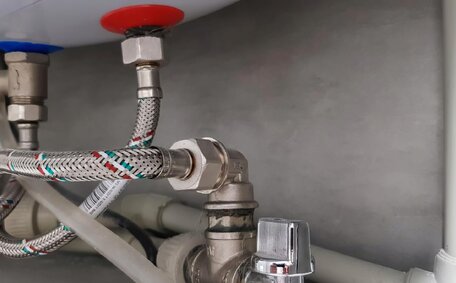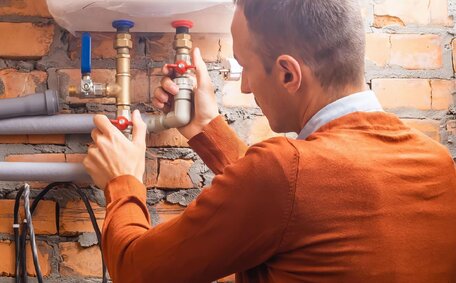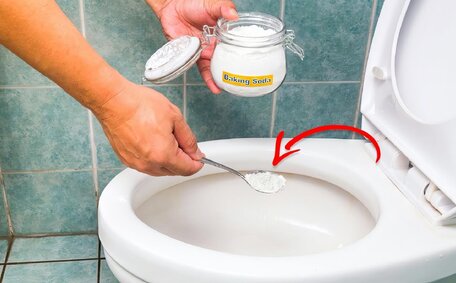Preparing the Space for a New Gas Cooktop
Properly preparing the countertop space is essential when installing a new gas cooktop. Start by reviewing the manufacturer’s guidelines for required clearances around the countertop.
Before selecting your cooktop, ensure to measure the space relative to cabinetry, maintaining at least 76mm of clearance on each side for safety. Most models require at least 76mm clearance on each side for safe operation and access.
When replacing an old cooktop, disconnect the gas and electrical connections to prepare for your new installation. Thoroughly clean the area beneath the base cabinets and perform any repairs to the solid surfacing to ensure smoothness and levelness. Use a spirit level to check the surface is even and check the alignment of the gas connector.
Scrutinise the present cutout dimensions and weigh them against what is required to ensure new appliance compatibility. Use a jigsaw to create the opening with precision for a perfect fit for your gas range.
Checking Gas Line and Electrical Requirements
When setting up new gas appliances like a stainless steel cooktop, it’s paramount to ensure the compatibility of your natural gas line and electrical infrastructure. Firstly, confirm the presence of a gas line shutoff valve nearby your existing cooktop. This provides a secure method to shut off the gas supply, including to appliances like water heaters, when needed.
Ensure the black gas pipe includes a reliable right angle fitting made from sturdy material, such as a 19mm pipe, to ensure a safe gas supply. Ensure your gas line and supply meet your cooktop’s requirements, which may include specific pipe diameters—for instance, 19mm pipes for optimal output. It would be astute to modify your gas line to accommodate the enhanced capabilities of a modern, efficient unit.
Ensure a qualified technician connects your cooktop to a 240-volt circuit, in line with its electrical requirements. Hire a licensed electrician to set up a dedicated circuit with the correct amperage, ensuring proper power point connectivity in your kitchen. Don’t tap into an existing circuit, as this risks overloading it when more than one appliances run at once.
Transitioning from an electric cooktop to a gas electric hybrid frequently necessitates expert intervention. The electrical and gas infrastructure needs modifying to facilitate the fuel switch. Licensed gas fitters employ the appropriate techniques for the entire installation, including new appliance gas pipes.
Removing the Old Cooktop
Before removing your old unit, make sure to turn off the gas supply. Locate the off gas cock near your cooktop and rotate it clockwise to the sealed position. First shut off the gas supply to avoid any leaks when dismantling your old cooktop.
Switch off the electrical power. Unplug the cooktop if it has a cord or turn off the circuit breaker supplying power to a hardwired model. Once you’ve secured both gas and electric safety measures, commence the installation of your new gas cooktop by removing the old one.
Use a Phillips screwdriver to remove any brackets or screws securing your old cooktop to the countertop.
Carefully remove the old cooktop, watch out for sharp edges, and place it aside on a protected surface. Thoroughly clean up any debris or leftover adhesive residue from under the countertop so the area is ready for the new gas stove installation.
Confirming Measurements and Clearances
Confirm that your new appliance fits seamlessly into the current countertop cutout before installation. Cooktop dimensions differ per model, typically ranging from approximately 762 x 508mm to 914 x 533mm. However, always check the specifications for your particular model.
If needed, carefully scribe and cut new lines on your countertop to create space for proper clearance.
Correct clearances ensure adequate ventilation and safe access to the gas range.
A cutout that’s too large for your gas cooker may lead to harmful combustion gases escaping.
Take precise measurements and check your figures repeatedly against the cooktop’s manual.
Installing and Connecting the New Gas Cooktop
Adhere strictly to the manufacturer’s instructions for clearances and cutout dimensions when installing your new gas cooktop. Fit new gas line connectors and securely fasten each pipe joint. To prevent leaks, ensure gas connections are airtight by applying quality pipe joint compound or wrapping Teflon tape tightly around pipe threads.
Ease the new cooktop into its designated spot, making sure it aligns correctly, to get your cooktop going smoothly within the cutout. Insert the end fittings, also known as end connector adapter fittings, and Begin by hand-tightening the screw connector, then use a wrench to ensure it’s securely fastened. Secure the gas connection to your cooktop, taking care not to cross thread or excessively tighten the fittings.
If you’re converting from an electric to a gas unit, engage a licensed professional to install a dedicated 240V circuit with the appropriate amperage. Connect this to your new cooktop according to the specifications. Ensure all gas electrical systems and connections exhibit steadfast security.
Apply gas leak detection solution to verify the absence of any small leaks in your cooktop. Tighten joints or refit connectors as needed until no leaks show. Wipe surfaces dry when finished and dispose of leak check solutions safely.
Once you finish installing new gas and electrical connections, turn on the supply and power to conduct an operational test. Confirm every gas burner ignition, including the wok burner, controls, and safety cut-outs are functioning correctly for safe cooking.
Testing for Gas Leaks
After installing your new gas cooktop, it’s crucial to test for potential gas leaks. Executing this step ensures that your efforts in installing a cooktop are not undermined by future safety hazards.
Start by mixing a leak detection solution, readily available from home centers and hardware stores. Apply it liberally on all gas fittings and connection points on your new cooktop using a small brush or dropper. Should bubbles form on your gas cooktop, this is undeniable proof that you’ve got an issue to attentively address.
Retest with the leak solution to double check.
If leaks persist, it’s an indication that you’ve got a faulty end connector fitting that requires replacement.
Should you face difficulty with resolving leaks, it may be time to summon professional help for all your gas-related needs. Our licenced gas fitters at North Epping Plumbing can inspect your cooktop installation and rectify any issues. We’ll guarantee a seal you can use with confidence, leaving no risk of dangerous gas leaks.
Understanding Compliance Needs and Professional Installation
When it’s time to install a new gas cooktop in your home, it’s crucial to understand and comply with all relevant local codes and Australian Standards. Due to the critical safety considerations with gas work, it’s often essential to hire a professional.
Fully licensed gas fitter professionals are extensively trained to safely handle gas line connections. They understand the compliance requirements and follow strict procedures to mitigate risks. Attempting DIY gas fitting without proper qualifications may lead to leaks, fires or explosions if done incorrectly.
Moreover, a licensed gas fitter is generally necessary for gas cooktop installations in a newly purchased home. A seasoned electrician, often found through sold home centers, can install a dedicated 240V circuit or oversee the transition from electric to gas. They can ensure your electrical infrastructure is code-compliant and able to safely power the cooktop.
The licensed gas technicians at North Epping Plumbing are fully accredited and perform your gas and electrical work to exceptional standards. We stay current on the latest regulations and best practises for every job. Our professional credo is to back your gas stove installation with the utmost attention to safety and compliance standards.
If doubts present themselves concerning your gas or electrical systems, don’t hesitate to call your local gas company technicians. Reach out to your local gas experts at North Epping Plumbing to learn more about compliance with legal requirements for your new gas cooktop.
Verifying Safe Functionality
Once your new gas cooktop is fully installed, it’s crucial to verify everything is working properly before first use. Conduct a thorough functionality check by turning on the gas supply and electrical power.
Carry out a visual inspection of all gas fittings and connections to safeguard against leaks, especially if they’re part of a new kitchen setup. Use a gas leak detector solution if needed to double check.
Turn on each burner of your gas stove, starting on low flame settings. Verify the igniter sparks and lights each burner.
Gradually increase the flame height, ensuring a strong, even flame and no abnormal sounds. Run each burner for 5-10 minutes, inspecting for potential gas leaks underneath. Also confirm the control knobs, timers and safety cutouts are all functioning as intended.
Consult the owner’s manual for guidance specific to your appliance’s operation. Over time, periodically inspect the fittings, perform leak tests, and check burner functionality remains in good working order.
For ongoing maintenance or any installation or functionality issues, the experienced technicians at North Epping Plumbing can assist. Feel free to contact us to service your new gas cooktop or troubleshoot any issues to ensure safe operation for years to come.






